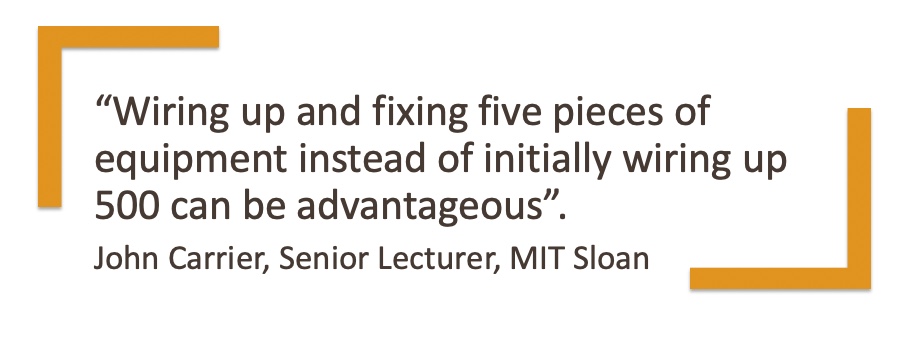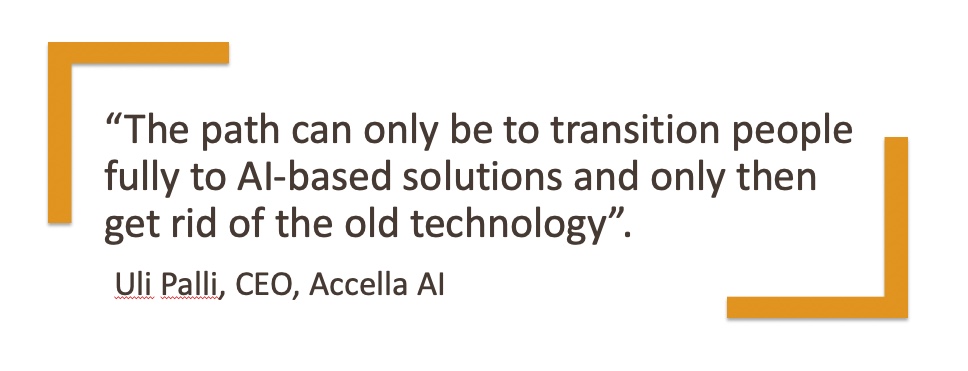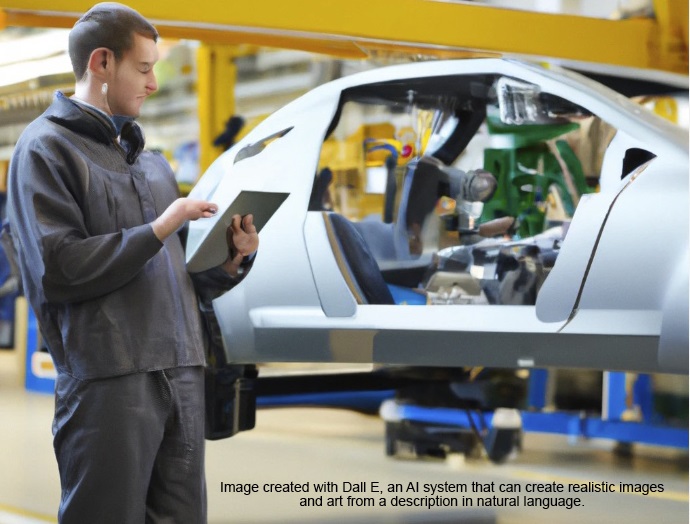Recently Facebook served up a sponsored post in my feed that caught my immediate attention: an article about the work of John Carrier, a senior lecturer at MIT Sloan, about the challenges of manufacturing companies transitioning to Industry 4.0.
This drew my attention, not just because I am a Sloanie myself, but because helping companies deploy AI-based solutions and supporting their move to Industry 4.0 is what we have been doing at Accella AI for the last five years. We’ve learned a thing or two in the process and were excited to find out whether the work done at Sloan and our real-life experience match up.
Do Theory and Practical Experience of Transitioning to Industry 4.0 Match Up?
The answer, mostly, is “Yes” with a bit of “Yes, and” and some “Not really” thrown in.
Let’s start with what we agree on.
Lack of standardization of the “old ways” is indeed a major challenge. We have yet to walk into any company and say “we have seen it done exactly this way before”. This isn’t really surprising, manufacturers have often been around for decades and have grown both organically and via acquisitions. With different legacy systems abound, standardization doesn’t come naturally. It’s surprising to find anything standardized even within a company.
That’s how it is, and we have to work around it.
The Ghosts of Old Technology – namely the fact that people tend to revert to what they know, i.e. old technology, when facing challenges – is basic human nature. Frankly, it is quite a bit more pronounced in manufacturing than in other, “younger” industries. If you walk around a shopfloor anywhere in the US or Europe (admittedly, we haven’t walked Asian shop floors just yet) you will see a lot of grey hair.
What you don’t see is MIT data scientists or young computer science grads. They work at Google, Facebook, Amazon, or the latest hot start-up. I am not saying that grey hair spells an inability to change, but that a lifetime of doing something successfully one way makes it harder to change than coming at it (relatively) fresh. Fact is – and part of what we are trying to do is changing this – that manufacturing is not sexy, hiring is a huge challenge and so the winds of change aren’t blowing as briskly as one would like.
Again, that’s how it is and we have to work around it.
Workforce Training and AI Custom-Built for the Shopfloor
Here we come to our “Yes, and”: companies do indeed need to focus more on workforce training, but that’s not all; those of us developing AI-based solutions for manufacturing need to come up with products that do not require a Ph.D. in data science to implement and maintain.
We need to develop solutions that can be managed – with training – cradle-to-grave by the people who run manufacturing: technicians and operators. Their often decades-long experience is invaluable and companies cannot afford to lose or ignore it.
AI solutions need to be custom-tailored to the needs of these users, rather than expecting them to become experts in data science with some internal training or a course at the local community college.
Another Whole-Hearted Yes to Focus
Initially focusing on a few problems – or even one – is exactly what works the best in our experience. Taking a measured approach is critical, as most organizations can’t handle too much change too soon.

Again, that is not surprising. Something new and different needs to show that it works and has value over and above what could be achieved by tweaking the existing solution.
Our advice to new customers is to start with one project that is spearheaded by an internal champion. Ideal proof-of-concept studies either address a problem that so far has proven intractable, adds high value, or – pragmatically – one that can be tackled quickly because there is enough existing data to feed the algorithm.
As the article points out, internal resources are critical to be able to “identify opportunities for improvement and value creation”.
The “Not Really” Part: We Don’t Recommend Burning Bridges
There is one suggestion we can’t stand behind: we don’t recommend burning bridges by removing old systems quickly during the transition to Industry 4.0.
True, there is a danger of people reverting to the old ways if the new ones don’t deliver or are too complex, but ripping out these legacy systems is a high-risk way of managing change. A lot of people are invested in the old technology and removing these solutions will make you a lot of enemies, specifically of the people you most need to be your allies: the ones managing production lines day in and day out.
In our experience, the only viable path is to transition people completely to the new system, earn their buy-in and support and then get rid of the old system.

Industrial revolutions don’t happen overnight. Moving to Industry 4.0 or Smart Manufacturing is no exception. Transitioning successfully requires deep understanding of manufacturing processes, the people who run them and industry trends.
Successfully transitioning also requires – more than in most other industries – shielding users from the complexities of AI and providing them with intuitive tools and platforms to manage the entire life cycle of dozens, hundreds or even thousands of different specialized models in their plants.
Our job as providers of AI-solutions for manufacturing is to work within those constraints and provide products that ease the move to Industry 4.0.
And maybe, in the process, we’ll also make manufacturing sexy again.
If you would like to know about how AI defines Industry 4.0, you can read our article about how AI makes manufacturing Better, Faster, Cheaper – AI for CPG Manufacturers


Great article and I also agree with you. Transitioning to Industry 4.0 tech and AI will also be an organic process in the majority of manufacturing companies today. Integrators like yourself provide the much needed expertise to make this possible, the link between the MIT lab results and where the rubber meets the ground. Thank you for sharing.